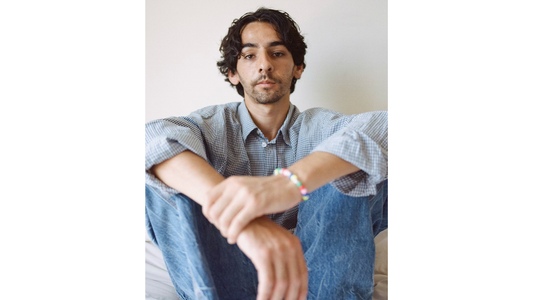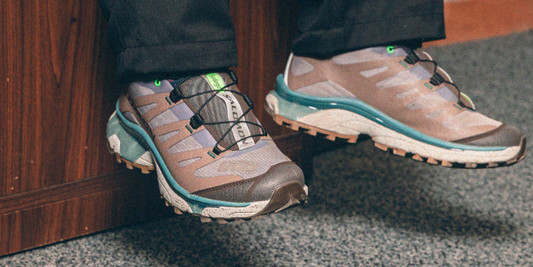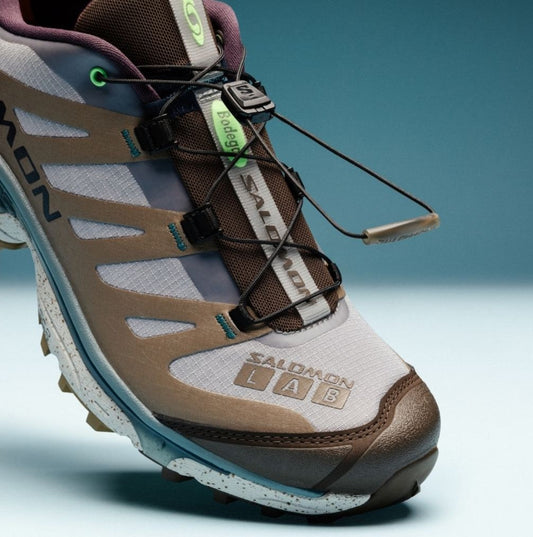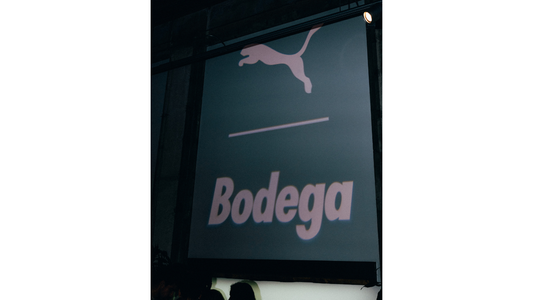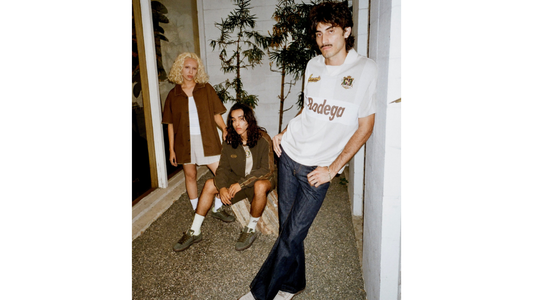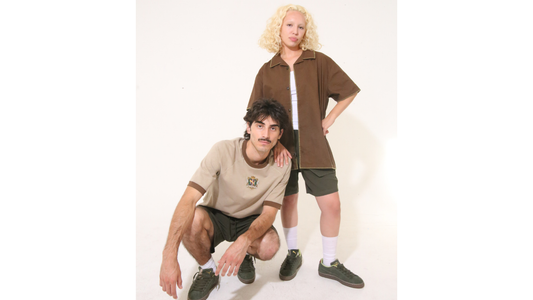Mihara Yasuhiro’s signature style of footwear is at once strikingly familiar, yet completely unique.
While his 15 years of highly regarded collaborations with Puma set the standard for designers working with sneaker companies, it was Yasuhiro’s OG Sole collection that began production in 2019 that are inherently his. First constructed with clay and then scanned into a computer, Yasuhiro’s distinctive designs have been likened to wearable pieces of art. Bodega recently caught up with the designer to talk about his design process.
Q&A
Why were you interested in making/ designing shoes? What made you interested?
When I was an art school student at Tama Art University, I started making shoes by hand. First of all, the reason I wanted to study art was that I was interested in creating a sort of “HARMONY” between humans/people and art. More than an art that is aimed to exhibit at museums or galleries, I wanted to create something that humans/people use daily and I thought that the HARMONY can be born and expressed.The concept of a shoe (as an object) was very attractive to me. It looked like a symbol of consumption/use. People wear shoes, and move, step and walk in them. The ways how the soles are worn out are different depending on the person.
Tell me about your first job as a shoemaker.
I wanted to see how a shoe is made so I started visiting shoe factories. Fortunately, there are leather shoe factories in Tokyo. I just started to hang out with people working there and tried to help. I was not even hired as a part-time employee [haha]. I tried to help putting labels on things, anything I could do to help. After a little while, some people at the factory started showing me more of the process of making a leather shoe. Step by step, I was able to learn pretty much the entire process, including how it’s sold et cetera.
When and why did you decide to start your own brand?
I had a desire to create something that could be called “Product.” Unlike an art piece, I figured that it is difficult to make a “Product” myself, even though I started making leather shoes for friends. It seems that I may have wanted to deny the scarcity value that art generally has. “One of a kind,” “only one in the world,” those may sound special but it was different from the concept I had. I felt that the way of creating something like that seemed “limited/ finite” in scope. In order to see a harmony between human and art expressed, my work needed to be “Products.”
I made a few pairs of shoes with the craftsmen at the factory and I simply decided to show these to people. I had an exhibition like an art exhibit. I didn’t even think about a way of showing as a brand or anything like that. I was an art student and I wanted to show them and see the reaction of visitors and people who looked at those shoes. Some people showed interest and said that they want to purchase them. I could actually get orders from those people and some retailers as well. haha
To be honest, it would have been the beginning as my own brand, however people at the factory actually yelled at me though. [Laughs] I had done that all on my own without any advanced permission. The scene and situation at the exhibit was a part of the “HARMONY” I wanted to see. I could see the opportunity that the “HARMONY” could happen. Also, the factory showed understanding after some conversations. They kindly gave me a lot of support. This all started about 2 years after I started to learn about making shoes. In 1986 I launched and opened the shop named “ARCHI DOOM.” I renamed the brand name to “MIHARAYASUHIRO,” when I graduated college in 1997.
Your epochal adventure with Puma started in 2000. How did it happen?
I had an idea— creating a sneaker style of design by using leather shoe techniques and process. People in the fashion media described that it’s an epoch-making or innovative approach. Of course I appreciated receiving those compliments, but I had to question it. “Is it innovative?”
“Authentic” and “Craftsmanship,” people use those terms when they talk about leather shoes. To be really honest, I am not a big fan of those terms. I wondered whether or not craftsmen of leather shoes in old times used those terms. I don’t think they did. I wanted to be even more “innovative” when I made leather shoes, but at same time, I was motivated to have deeper knowledge about other types of footwear as a shoe-maker/designer. When I looked through the footwear industry, it seemed that the category of sneakers is a more innovative mentality. Of course, I was pretty motivated to keep making leather shoes as I had done, but I realized that the best way to learn much more about “sneakers” would be working with a sport brand or sneaker company.
I just started calling major sport brands, but I was told, ‘We design and make our products (sneakers) for athletes only.’ Also, “I don’t understand what you’re saying. Why does a fashion designer like you want to work/ collaborate with us?’ It was an answer that nobody would believe now. [Laughs]. I didn’t even care which brand I wanted to work with. I just wanted to work with a major sport brand to make sneakers together. I just started calling any of those that I could find a phone number for. Puma was not the first one, but luckily the Japan office (the exclusive agent for Japanese market in those days) of Puma showed interest. They decided to launch this project as a Japanese only special premium project. The year 2000 was the coming year at that time, so we both decided to move forward with a limited edition of 2000 pairs to celebrate the year 2000. That’s how it was kicked off.
I heard that all of those sold out in a couple of days and it became a high-priced sneaker. They couldn’t believe that it sold out that quickly. Remember, at that time, there was no internet. So consumers who wanted to purchase or have more information just started contacting the Puma’s headquarter in Germany. There was not even the term “collaboration” at that time. The German headquarter knew about the project. Anyways, they couldn’t believe that it went so well like that and they flew to Japan right away to see me. The next season, the project was continued as a global project. I wouldn’t have ever thought it would still be happening in 2015.
Unlike most designers, your own shoes seem quite different from the collaborative shoes that you have made? Would you agree? Or do you see some similarities?
Yes, I would agree. When I started collaborating with Puma, the term “fashion collaboration,” which people are now familiar with, didn’t exist. So there was no format of working with a fashion designer in these sport brands/ sneaker companies. I didn’t have the knowledge or technique of sneaker developing, so I simply brought my knowledge, ideas and techniques as a leather shoe-maker. Naturally my attention was paid to the whole process from sole to upper. Nowadays, a designer or design department of these companies will bring a design idea, draft & et cetera. At that time, there was not such a way, format or system. I had to get involved with the whole process. That made a huge difference.
Anyways, I am more than happy to be involved with the whole process when I work/collaborate with someone else to make sneakers. I want to create a synergy and “Harmony” with the collaborator, when I collaborate with someone else. Every brand has their own “universe”, direction, and target, price point and blah blah. When I consider those factors/ elements with a lot of aspects, the collaboration product has to be different from a product of my collection and my brand. And it’s fun to create that “difference” when I collaborate with someone else.
Have you seen your vision/designs change from when you began? If so, how?
It has not changed…actually. A few years ago, I was really conflicted about it. Why has it not changed? I should change though.
What would you say makes your shoes "Premium?"
I never think that my shoes are “premium” [Laughs]. Especially when I worked with Puma. My own collection is primarily made up of leather shoes. Pumas are a type of sneaker. That’s how I separated them in my mind when I created them. After 15 years with Puma, my motivation about creating sneaker styles has become even higher, but with a somewhat new technique and for my own collection. I felt that it was time for my own brand to create sneaker styles on my own, in earnest, with my team here. Experimentally, I designed and made a couple of different styles in these couple of seasons, until I created this OG Sole series. I knew from my experience with sneaker design that I did not want to rely too much on “technologies”. Anyway, my company is too small to invest in the latest technology like major sporting brands do. At the same time, my interest or motivation had become the challenge of creating something new or different without relying on those “technologies.” I knew that it can be interesting and attractive to design and create something that can not be expressed easily by a technology, such as a 3-Dimension CAD system. I realized that it would be quite interesting to design and make a sneaker style by combining low-tech” and “high-tech”. It would not sound like an “evolutionary idea, but it would be an “Innovative” idea.
At that time, on my mind, I considered the process of designing a shoe like approaching a “Bonsai.” The territory of creativity is limited in a way. A shoe is a 3 -dimension thing/object, but the creative territory is simple or narrow in a sense. I wanted to create footwear in the sneaker framework and find other ways to express the concept. A sneaker that wasn’t meant for sports. Sneakers as footwear. It’s what I wanted to create, and it had to match with my own collection. I was motivated to create a sneaker that has different shapes between right side and left side. It would be something different from your usual sneaker. The hands-on process of making the sole of this OG series is like play dough. And from there we use technology to develop this as a sneaker sole.
Please explain about your pride of the craftsmanship on your shoes as opposed to mass produced big sneaker companies?
I am not a big fan of the term “craftsmanship”, as you may realize. I’ve actually asked my team not to use the term when they talk or explain about our products. For the first edition/ design after I left Puma, I thought a lot about the general sense of value and beauty. For example, the curve of the side on the sole would look beautiful. The beautiful curve can be expressed even more by “high-tech” computers. I applied the hands-on process when this sole is created and made and these shapes and curves by a “high-tech” approach. “Distorted?” “Deformed?” “Misshapen?” “Uneven?” I don’t know the exact expression, but anyways, people are somehow fascinated by such shapes, and they think they’re beautiful.
I questioned why people think it’s beauty. And, I realized that Japanese might have been good at those shapes and beauty if you pay attention to traditional things in Japan. Bonsai, Chaki (tea ware), Pottery, ceramic art. A lot of those do not have perfect circle or line, and, of course it is on purpose. On the other hand, at the same time, Japanese or work products by Japanese are often said to be very precise and accurate. I figured out that this balance is the expression of how I should design and create. Utilizing such uneven forms or shapes is challenging, but it can be quite interesting and important at same time. That’s the creating process and background of how OG Sole series was born.
I wanted to find other approaches to suggest a new sense of value on the current fashion scene, sneaker scene, or market. Then I started making the sole shape by clay like a play-dough, get it scanned and repeat over and over—to give both sides of the soles a different look and shape. I don’t use 3-D printers, I simply scan the clay I make. The scanning process as a technique was hard to actualize when I was young, but now it became a more simple process. It would be described as a sort of “fusion” between “low-tech” and “high-tech”. The sole process starts by hand “low-tech“ in the beginning, and uses the process by computer “high-tech”. It's a simple scanning process, and it’s more fun than 3-D printer technique, because I can play more around during the process. For instance, I enjoy making the differences between the right and lefts soles of the shoes.
What shoes do you wear? Both of your own, and of others?
I am always interested in wearing other sneakers, but I want to wear my own samples myself as a test. Every season, I make some new sole or design, so I don’t have much opportunity to wear other’s daily.
Tell me about a few shoes that inspired you in your formative years.
Around the 80’s in Japan, the “disco” movement was really “in” back then. I had a chance to go to a “Disco” close to my local town called Nakasu, when I was an elementary school student, around 10 or 11 years old. The disco was really small, and it was called “Super Music,” and it only played Black music. On the floor, they played movies such as “Wild Style”, “Beat Street” and so on. The sneakers which the breakdancers in the movie wore inspired me a lot, and it would be my first encounter with a sneaker. I started to surf a bit after that time, so I got inspired by sneakers from the US based on surfing and skateboarding cultures in addition to the black culture and breakdancers. I got inspired by punk music for leather shoes in the beginning. The leather shoes from punk music were more from the UK cultures, but the sneakers were probably from US culture.
Can you talk a little bit about the idea of “Original Sole” and paying tribute to influential sneakers of your youth?
Yes, it would absolutely be paying tribute to influential sneakers of youth.


